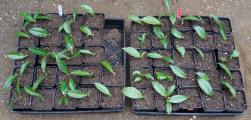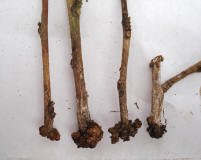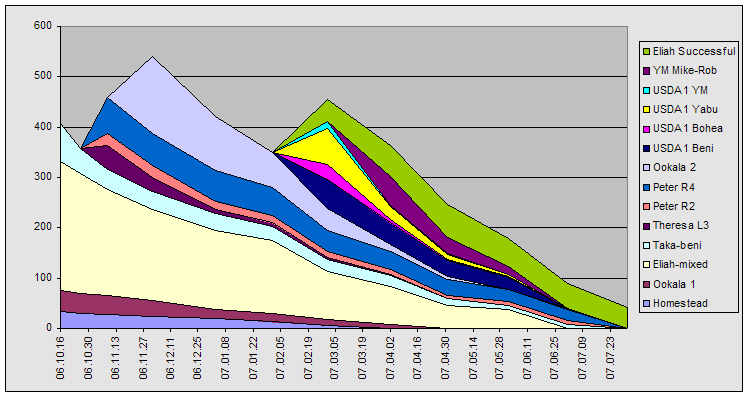tea notes
These notes are maintained by
Ben Discoe.
Tea Plants: Availability of Cuttings
- There is a real crisis of availability of plant material. There are
large government fields of tea, especially at Mealani, but distribution of
cuttings from there has been held up for various reasons.
- HTS / Mealani
- July 2006. It sounds like HTS has finally almost lined up some
volume tea cuttings for distribution! Hooray.
- August 2006. A few thousand cuttings were made available from
Mealani. The HTS distribution did not turn out so well; a few people
bought them all up within 2-3 days. We didn't get any. There is
reportedly a waiting list, but no way to find out if we're on the list
or not.
- October 2006. At the annual HTS meeting, it's is announced that:
The demand for tea cuttings was estimated at around 25,000. The goal
for 2006 was to distribute 5000. 3200 were distributed so far, with
1500 more expected in 2006. There were 8 people on the waiting list.
- January 1, 2007. Announcement is made of availability of cuttings,
from Mealani through HTS. Price has soared from $1 to $2.50 per
cutting, so less well off people (like us) can't afford many. There is
no mention at all of the waiting list - whether we are on it or not,
apparently the list was forgotten.
- 2008: There is still no organized distribution of Mealani's
cuttings.
- HTS Propagation Program: May 2008, looking for people to contribute
cuttings.
- October 2008: At 'Taste of the Hawaiian Range', Eva reports that
there are 4 people doing the propagation.
- USDA Volcano Field Office also distributes branches, for making
cuttings.
- Every few months small batches are made available. There is no
charge, and the amount is a "small bucket".
- They sometimes have CSO, although most people find
that CSO just dies or grows poorly. In my case, the CSO all died
eventually.
Tea Plants: Propagating Cuttings
- The Tea Society has given demonstrations on how to propagate cuttings,
and Mealani has published their approach to in-ground propagate cuttings, so
most of us growers have an idea how to do it. However, most people have had
very poor results.
- In my own experience, i've tried the following.
- In all cases, i made cuttings with garden clippers, dusted them in
"root tone" or similar rooting hormone powder, placed them in my
greenhouse in the shady area under the tables, and watered daily to keep
them moist.
- 2006: started >100 cuttings in compost/topsoil
- 2006: started several hundred in subsoil

- 2007: started >100 in a tray of soil at an angle, as recommended by
a Taiwan tea grower
-

- 2008: started two batches in
Oasis Root Cubes

- In every case, almost all the cuttings died. In
some cases, a few weak plants survived long enough to be planted in the
field, but they grew slowly and barely made it. Out of >1000 cuttings
in 2006, less than 45 were alive in 2008.
- My own blog posting related to cuttings:
- Anecdotally, many other growers have had similar problems.
- "All my cuttings died." "We've tried everything, both root
cubes and soil, timed watering systems with mist." "At best, 10% of my
cuttings made it."
- Who has success?
- CTAHR. The Mealani 2006 report "In-Ground Procedure for Rooting Tea
Cuttings" claims a "high percentage" of "takes", visibly better than 75%
success rate.
- Aileen Yeh. She is a professional and accomplished nursery person.
She reports as much as >90% success rate, and the resulting potted plants are strong
and vigorous. She supplied almost all the plants in my own tea field.
- Why might our cuttings be failing?
-

 It
might be a soil issue, with root knot nematodes. (see
Tea cuttings not making roots) Perhaps the success that Mealani had
in soil, is due to their use of anti-nematode chemicals at some previous
time in that part of their test field. Their report doesn't say.
It
might be a soil issue, with root knot nematodes. (see
Tea cuttings not making roots) Perhaps the success that Mealani had
in soil, is due to their use of anti-nematode chemicals at some previous
time in that part of their test field. Their report doesn't say.
- It might be bacteria, fungus or
other infectious problem. The Mealani report says "Shoots can be dipped
in a disinfecting solution, such as hydrogen dioxide, for 2-3 minutes
just prior to sticking." It doesn't say if they actually did this, or
if that's the whole cutting or just the tip. 2-3 minutes is a long
time to hold each cutting in a solution by hand.
- It might be moisture. Watering once a day in a
greenhouse might not keep the moisture level continuously high, even
with root cubes holding moisture around the stem. In Mealani's
report, their cuttings were entirely enclosed in a small, shady area.
- It might be the hormones. Some of us growers have
tried "Root Tone" or similar hormone powders. Aileen Yeh reports that
she uses a more powerful product called
Dip 'n Grow (active ingredient is
IBA),
which is available in Hilo from
United Agri Products, 900 Leilani St., close to the Airport Road.
It's also available online, but they apparently don't ship to Hawaii.
- It might be temperature. For example,
upcountry here in Ahualoa (~2500'), it can get chilly on winter nights,
down to 48F/8C. If not fatal, it could at least really slow down
the rooting. Perhaps the colder months should be avoided.
- Any other ideas?
- The very brief article 'Planting
the Tea' on the HTS site says:
- "Propagation of tea plants needs a facility where constant
temperature 75º-85º and humidity (80%) are maintained. Bacteria and
fungi control is very important during propagation. Most propagation
failures are due to dryness, bacteria and fungi infections."
- 'Tea Cultivation' by N. Ghosh Hajra has much advice (pp. 156-177), based
on large plantations in India.
- "Cuttings with an axillary buds root quicker. 15 to 21 days
prior to taking the cuttings, the terminal bud should be pinched off to
initiate the axillary buds to sprout."
- Although single-node cuttings can result in more plants, multi-node
cuttings have a better success rate.
- Zinc sulfate is mentioned, both to spray on the mother plants at 1%
solution 21 days before taking cuttings, and at 0.1% solution for
dipping each cutting.
- "Rooting soil should be a sandy loam, porous and friable with a pH
from 4.5 to 4.8, though up to 5.5 is not entirely harmful. Soil pH
beyond 5 tends to promote excessive callusing at the expense of rooting.
Soil with pH above 5.5 should be rejected. The organic carbon
content of the soil should be between 0.8 and 1%. Soils with a
high clay content may be avoided since it will not drain well enough.
Sub-soils up to a depth of 90cm can be used provided well decomposed
manure (1 part manure, 5 parts subsoil) are added. Addition of
concentrated organic manures to sub-soil resulted in high casualty of
the cuttings."
- "Soil must be analyzed to ascertain the level of nematode (eelworm)
infestation. Soil having root knot nematodes less then four per
10g of soil can be used." For non-organic growers, it mentions
"Application of 2g Furudan 3G"
- "Only 50% or less light should be allowed to fall on the [cutting]
beds in a diffused manner."
- "Observed optimum temperature for growth of cuttings was 25-30C.
Less than 5C or more than 45C was lethal."
- Rooting Hormones
- See wikipedia page on
Plant Hormones.
The most commonly available is an
auxin
called
Indole-3-butyric acid (IBA). That's what's in most
commercially available powders and in Dip-n-grow.
- 'Tea Cultivation' reports contradictory findings: "The effect of
some growth regulators on rooting has been investigated by Barman and
Manivel (1986) and found
triacontanol
significantly better than others. Trials of a large number of pure
rooting hormones and some proprietary preparations showed
IBA
perhaps the only hormone which hastened root growth in tea cuttings and
produced initially a large volume of roots (Anonymous, 1992). In
south India, Rajasekar and Sharma (1989) observed that IBA at 5000 ppm
in combination with zinc at 2500 ppm in solution induced higher percent
of rooting and enhanced the length and dry weight of roots and shoot."
- Q Plugs
- Most people have been trying to root cuttings in soil, or Oasis
Cubes. But as of 2008, Aileen Yeh reports good results with
another product, more natural, called
Q Plugs from ihort.
Strangely, the ihort website doesn't say exactly what these plugs are
made of.





 It
might be a soil issue, with root knot nematodes. (see
Tea cuttings not making roots) Perhaps the success that Mealani had
in soil, is due to their use of anti-nematode chemicals at some previous
time in that part of their test field. Their report doesn't say.
It
might be a soil issue, with root knot nematodes. (see
Tea cuttings not making roots) Perhaps the success that Mealani had
in soil, is due to their use of anti-nematode chemicals at some previous
time in that part of their test field. Their report doesn't say.